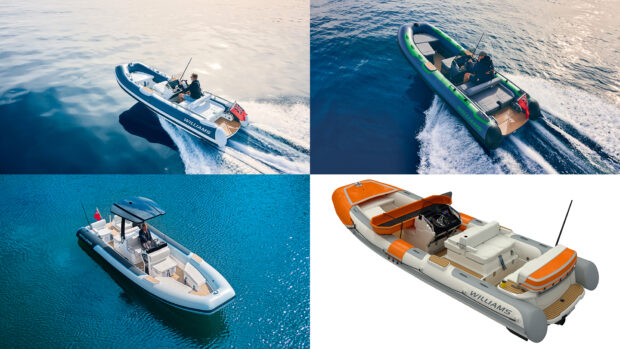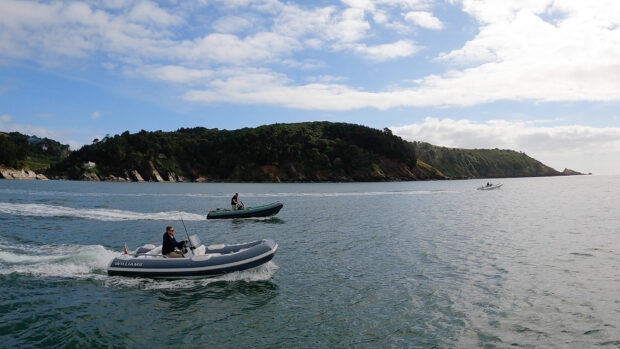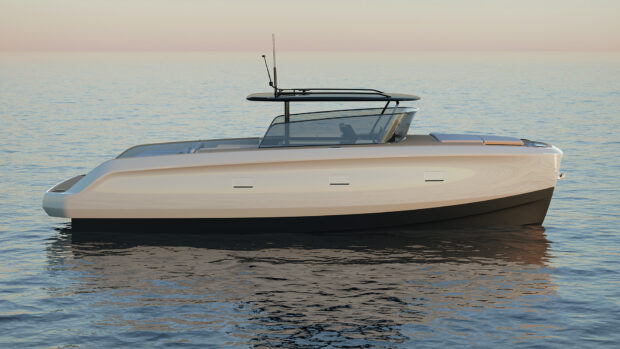Could SEAir's foiling RIB change boating forever? We head to their HQ in France to test it out. Read all about it and watch the video here
Within the boating fraternity, foiling is the word on everyone’s lips at the moment. Be it the spectacular AC45s raced in the last America’s Cup or recent confirmation that Princess will be pioneering the use of a new high tech Active Foiling System on its forthcoming R Class superboat.
Yet even in the realm of powerboats, hydrofoils are nothing new. Italian inventor Enrico Forlanini began work on them in 1896 and when Alexander Graham Bell and his chief engineer Casey Baldwin first tested Forlanini’s hydrofoil over Lake Maggiore, Baldwin is said to have described it as being “as smooth as flying.”
What is it about the SEAir RIB, then, that moves the game on and demands closer attention? The company’s mission is to bring foiling to the masses and dispel the notion that it is a dangerous way to travel, only to be attempted by professionals and race-hardened sailors.
Carbon-fibre foils

SEAir is based in the hotbed of sailing innovation that is Lorient, Brittany, and was founded 18 months ago by Richard Forest, Bertrand Castelnérac and Benoit Lequin. As CEO, Forest is an engineering enthusiast responsible for bringing in investment whereas Castelnérac and Lequin are sailors through and through.
Lequin, who is in charge of engineering, holds the record for crossing the South and North Atlantic in an open catamaran and it was Castelnérac who, while watching the support RIB struggling to keep up with the foiling racing yacht, had the light bulb moment.
We meet the trio inside their ramshackle workshop near Lorient’s port, the office walls plastered with technical drawings, graphs and equations all dedicated to the art of hydrofoils. Inside the shed are the hulls of three Zodiac RIBS, two 7m versions and a 5.5m identical to the one we are here to test.
SEAir is not a boatbuilder; it is a producer of foils and the associated technology. The company decided to start with a RIB and approached Zodiac, who agreed tentatively to take part in the project. Zodiac has since described the SEAir as the greatest innovation it has seen in 20 years of RIB building.
The foils are 100% carbon fibre and take two weeks to make by hand. There are over 100 layers of carbon- fibre weave in their construction and they are infused with resin before being oven-cured. SEAir also has the use of a five-axis robot that can make two foils in three days using prepreg carbon-fibre strands.
Prepreg, as the name implies, is carbon-fibre matting that has been pre-impregnated with a resin, often epoxy, so that it is ready to lay straight into the mould. This process is faster but more expensive. One of SEAir’s major obstacles is producing the foils to an incredibly high standard yet ensuring they remain affordable enough to appeal to the mass market. A tough brief.
The foils, which weigh only 17kg each and are incredibly strong, are then slotted through the hull into a reinforced composite box and held in place using a pair of Dyneema cords and the sheer force of water pressure. Such is their inherent rigidity, two fully grown adults could stand on a deployed foil and it wouldn’t budge an inch.
Given the extreme forces coursing through these ornate structures as the RIB glides out of the water, it’s a comforting thought. The engine is a standard 115hp Yamaha outboard, though it is the long shaft version, and it’s fitted with a pair of extended fins to increase the amount of lift produced at the stern.
There is a smaller plate fitted about halfway up the outboard shaft to deflect spray from the propeller, as it rotates at a shallower depth than usual. The yard believes the standard 115hp outboard that comes with a Zodiac 5.5m is overpowered for the more efficient foiling version so the 100hp or even 90hp alternative would be a better match.
“It is key,” says Forest, “that the foils integrate seamlessly with how the boat operates and do not detract from the original product or alter the way the boat has to be used in any way.”
The million-dollar question

We’ve heard the back story and seen how the hydrofoils are made but most importantly, do they work? Lorient’s harbour is renowned for its protection from the moody Atlantic, but days of squalls ensure that there is some fierce residual swell to have a play in outside the protection of the port.
The SEAir RIB is rafted alongside a standard 5.5m Zodiac with the same engine, which will act as a chase boat and handy back-to-back comparison with its foiling cousin. To look at it, you would have no idea that the SEAir is any different to the standard RIB, especially as the murky water means you can’t see the foils.
The only clue is a trio of rocker switches on the dashboard that raise and lower the foils and control their angle of rake. I stand in front of the helm, clip on the kill cord and take hold of the wheel and standard Yamaha throttle – so far, so normal.
Even though the foils can be lowered and retracted in 20 seconds, I leave the berth with them deployed to see if the sensation is any different to normal. It isn’t. There’s no sensation of the appendages jutting down below the waterline and the boat behaves at slow speed just as it would normally.
On this prototype version, the rake of the foils has to be set before you increase the speed as the actuators aren’t beefy enough to do it on the move. We begin with the rake set to zero, which optimises the angle of attack for a cruising speed of 20-25 knots in calm conditions.
The pitch of the outboard is important in this process and the trim is set at 60% (100% is the outboard tilted fully up) to get us started. The foils begin to work at around 15 knots but aside from the bow rising noticeably (but not alarmingly) higher than normal, it doesn’t feel all that different to easing on to the plane on a regular hull.
By 20 knots, the foils are in full effect and we are gliding over the surface of the water with the forward sections of the hull gently brushing the surface in rhythm with the light swell running through the harbour. The sensation is strangely anticlimactic, which can be viewed as a positive in this context.
I expected the boat to feel more precarious, as if it could topple off its carbon-fibre stilts at any moment and crash back down to sea level without warning. This is not the case and in these calm conditions at least, the whole process feels entirely natural. We top out at 32 knots without adjusting the rake, though the team tell me that they have achieved 42 knots in their own tests with the thrill-seeking Lequin at the helm.
Getting to grips with foils

There are some handling characteristics to be aware of, however. Though the boat reacts to outboard trim in the same manner as a regular hull (trim up to raise the bow, down to lower it), the foils are much more sensitive to the adjustments.
Tiny changes to the trim of the outboard engine will make a significant difference to the running attitude and it takes time to get the balance correct. There isn’t a right or wrong way of doing it; it’s about setting the rake of the foil for the conditions and playing with the trim to find the most comfortable running attitude for the conditions.
The steering is much more sensitive at speed than it would be on the normal Zodiac and even small adjustments to the wheel prompt fly-like reactions. There is so much lateral grip generated by the foils that you need to brace yourself for the speed of the turn.
This is all well and good in a short chop, where the foils allow the boat to fly over the waves in remarkable comfort, but how does it cope in the rough stuff? We head outside the harbour into the rolling swell and find that a boat of this size can’t avoid following the peaks and troughs altogether, but the foils act like a pair of shock absorbers, dramatically reducing the vertical acceleration and softening the landings (as you can see in our video above). As we run alongside the regular RIB, it’s clear that its crew are having a much harder time than us and can’t keep up with our pace.
As well as the significantly better ride comfort, particularly in a short head sea, SEAir also claims an average 30% increase in fuel efficiency and as much as 50% in some conditions. We weren’t able to ratify these figures ourselves in the time available but French magazine Moteur Boat did manage to take measurements on both the standard RIB and the foiling version fitted with an identical 115hp engine, and have kindly agreed to let us share their findings in the table on the previous page. They also took two sets of readings at a steady speed of 20 knots and 25 knots.
In both cases, the engine on the foiling RIB was revving 250-300rpm slower to achieve the same speeds, reducing fuel consumption by 28% and 24% respectively. The ultimate dream for the boundlessly enthusiastic SEAir team is for mainstream boatbuilders to start offering a ‘foiling pack’ on the options list that customers can tick, just as they would an engine upgrade or teak decking.
Adapting this foiling system from a small RIB to a large cruising boat is fraught with difficulties but we’ve learnt enough from our sea trial of this remarkably effective prototype to believe that this could be the start of something truly transformative. 
Contact: SEAir

Foiling technology: everything you need to know about hydrofoils
Fitting foils to powerboats is all the rage, but how do they work and why is foiling back in fashion?

DutchCat: The 15p-per-mile-marvel motor catamaran
This electric or hybrid-engined motorcat takes fuel-efficiency cruising to a new level










